Introduction: Duncan Kuehn is a professional genealogist with over eight years of client experience. She has worked on several well-known projects, such as “Who Do You Think You Are?” and researching President Barack Obama’s ancestry. In this blog post, Duncan searches old newspapers to find the history of two taverns in Manhattan that archaeologists recently excavated.
I recently read an article on the website Archaeology about an archaeological dig in Lower Manhattan at 50 Bowery.* They have unearthed the remains of two historic taverns built on the same location. The older of the two, the “Bull’s Head,” was from the colonial-era. It was “built in the 1740s by a butcher near New York City’s first slaughterhouse.” The second tavern, the “Atlantic Garden” which opened in 1858, was “a tourist destination in its day—it was known for its German food and beer, and as a place for music and parties.”
I wanted to know more about the history of the two taverns, so I turned to GenealogyBank’s Historical Newspaper Archives to learn more.
Genealogy Tip: When searching through the newspaper archives, I entered phrases (enclosed in quotation marks) into the Include Keywords field to find the exact phrase in the newspaper articles. In this case I ran two searches, one with “Bull’s Head” and one with “Atlantic Garden.”
Interesting Tavern Tidbits
I found an article in a German American newspaper that discussed the origins of the area.
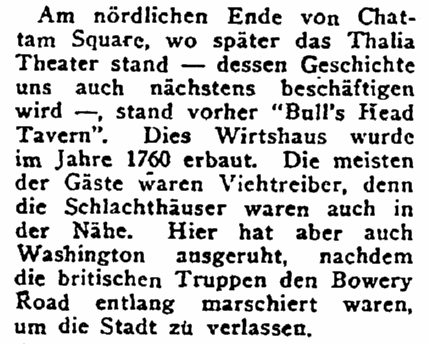
I only have an elementary understanding of the language, so I went to Google Translate and typed in the German paragraph that I was interested in. A loose translation told me that the tavern was opened in 1760.
I also learned that:
Most of the guests were cattle drivers because of the proximity to the slaughter houses. However, Washington had rested there after the British troops marched along the Bowery Road to exit the city.
The abundance of cattle drivers explains all the newspaper notices I found announcing cattle and horse auctions taking place at the tavern, such as this ad from a 1780 newspaper.
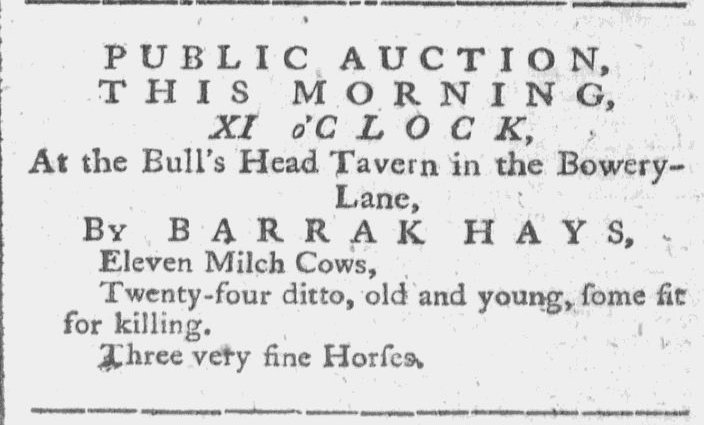
I also found an interesting reference to the story about George Washington, in another newspaper. This article explained that Washington had used the tavern as one of his headquarters during the Revolutionary War.
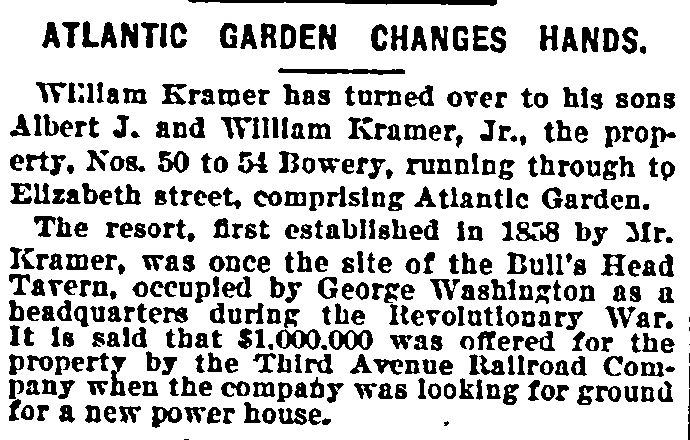
Land History
Note that this article also reports: “It is said that $1,000,000 was offered for the property by the Third Avenue Railroad Company when the company was looking for ground for a new power house.” Assuming that the offer was made about 1880 and adjusting for inflation, the railroad was willing to pay about $17 million for the premium Manhattan location!
Then I found this well-written newspaper article, telling about the history of this plot of land in New York City.
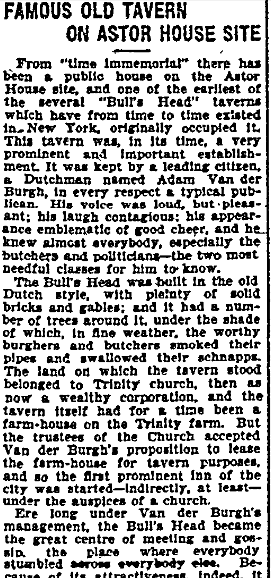
I learned that originally the land was owned by the Trinity Church. It was covered in trees and was a beautiful spot to build a gathering place for the local drovers (people who drive sheep or cattle to the market) as they came into town.
The old newspaper article provided this description:
The Bull’s Head [Tavern] was built in the old Dutch style, with plenty of solid bricks and gables; and it had a number of trees around it, under the shade of which, in fine weather, the worthy burghers and butchers smoked their pipes and swallowed their schnapps. The land on which the tavern stood belonged to Trinity church, then as now a wealthy corporation, and the tavern itself had for a time been a farm-house on the Trinity farm. But the trustees of the Church accepted Van der Burgh’s proposition to lease the farm-house for tavern purposes, and so the first prominent inn of the city was started—indirectly, at least—under the auspices of a church.
A church would seem to be an odd landlord for such a raucous establishment! The article says this of Adam Van der Burgh:
His voice was loud, but pleasant; his laugh contagious; his appearance emblematic of good cheer, and he knew almost everybody, especially the butchers and politicians—the two most needful classes for him to know.
As Van der Burgh’s tavern thrived, he soon attracted the ire of the local women “who went so far as to hold a meeting, and to protest against the alienating influences” of the place. He weathered that storm, but went too far when he built the first race track in New York immediately in front of his tavern. This drew the wrath of his landlord the Trinity Church. In response, Van der Burgh closed the race track “and, apparently from spite, abandoned the Bull’s Head tavern.”
The Tavern Keepers
This newspaper article explained that during the American Revolution, the tavern was owned by John Jacob Astor’s brother Henry.
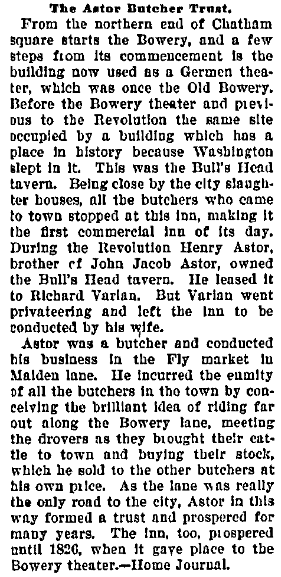
In addition to owning the Bull’s Head Tavern, Henry Astor was a butcher. A brilliant idea came to him: he beat the competing butchers by “riding far out along the Bowery land, meeting the drovers as they brought their cattle to town and buying their stock, which he sold to the other butchers at his own price.”
I found this illustration, showing what the Bull’s Head Tavern looked like in 1820.
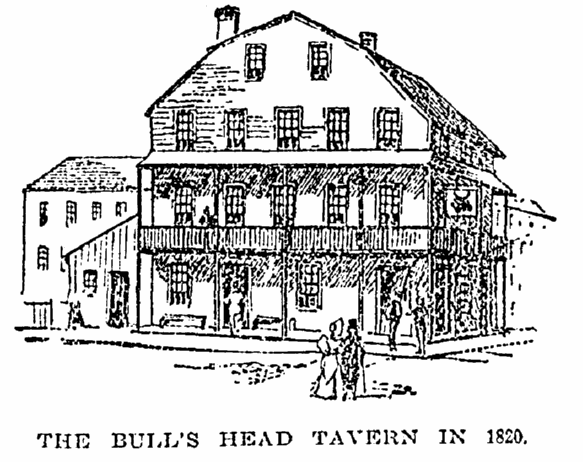
In 1825, the tavern was moved from the Bowery to Twenty-Fourth Street and Third Avenue. I learned this from the following newspaper article announcing the closing of the Bull’s Head Tavern. After 80 years in its second location, the tavern was closed down completely and the furnishings and fixtures were auctioned off.
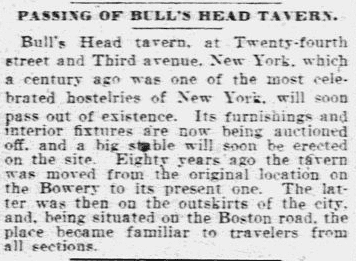
In the meantime, back at 50 Bowery, the spot was used as a stove factory before the Atlantic Garden was opened in 1858.
As the next newspaper article reported, soon after William Kramer opened the Atlantic Garden it became the recruiting station for the German regiments during the Civil War. Next door was the Thalia Theater where German language operas were sung. A passageway was built between the theater and the Garden to facilitate the opera patrons running over “for a bite and a sip between the acts.”
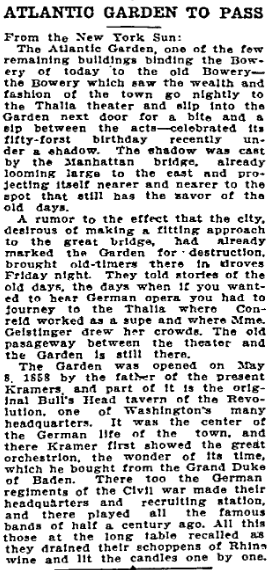
According to another newspaper article, Atlantic Garden became the center of German life in the city and was “a resort modeled after the amusement gardens of German cities.”
This old newspaper article also reported that the Atlantic Garden was about to be closed in 1911—slated to be torn down in preparation for a modern theatre and eight-story office building.
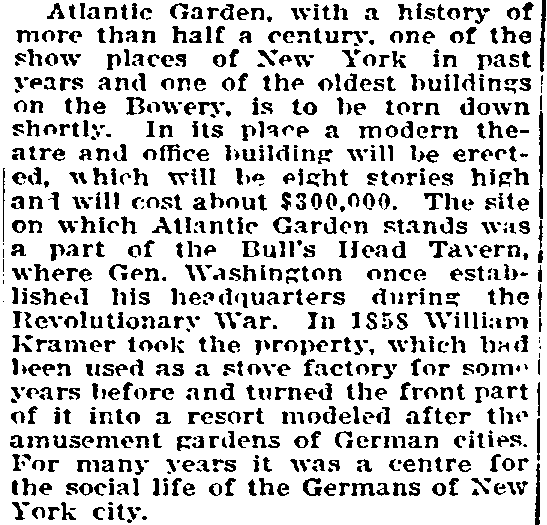
Historical Professional Parallels
And that brings us back to the archaeology article I read recently, that spurred me to do this research. Just as the archaeologists dug through the earth to find “liquor bottles, plates, and mugs,” we dug through a few hundred years’ worth of newspaper articles to learn more about the people and buildings. Long-dead Van der Burgh, Astor, and Kramer left their mark in more ways than one. Their objects will fascinate those on-site. And a brief glimpse into their lives fascinates us. Well done, men!
Most genealogists know that newspapers help tell the stories of our ancestors’ lives—but, as this article has shown, newspapers also tell us about the times and places our ancestors lived in.
Genealogy Tip: Even though this research was about taverns in New York City, note the variety of states where relevant newspaper articles were found, including: California, Massachusetts, Minnesota and North Dakota. This is a reminder that you should begin your search with a broad geographical scope; you never know where a newspaper article was published that might be about your ancestor or area of interest.
_________
* “Historic Taverns Unearthed in New York City.” Archaeology.com. May 5, 2014. Accessed June 1, 2014. http://archaeology.org/news/2083-140505-bowery-tavern-beer.
[bottom_post_ad]

Those of us who are descended from those historic tavernkeepers are eligible to join Flagon and Trencher (Society for Descendants of Colonial Tavernkeepers). If your tavernkeeper ancestor operated a tavern prior to July 4, 1776, get details at http://www.flagonandtrencher.org
Thanks for that information Gail. Such a fascinating history is associated with your ancestor!
I believe it to be a strong possibility that a piece of the Atlantic Garden is still in use today. The bar at Ruddy’s Landmark Cafe, located in Scranton, PA has a brass plate on the front that reads, “manufactured by J. Herron 50 New Bowery, N.Y.” The building the bar is housed in was erected in 1904 by John F. Leibig. Mr. Leibig had friends in New York City and would visit. Perhaps it’s possible he acquired the bar on one of his journeys. I’m still researching.
Interesting theory, Ronald. Thanks for sharing, and let us know what your further research uncovers.